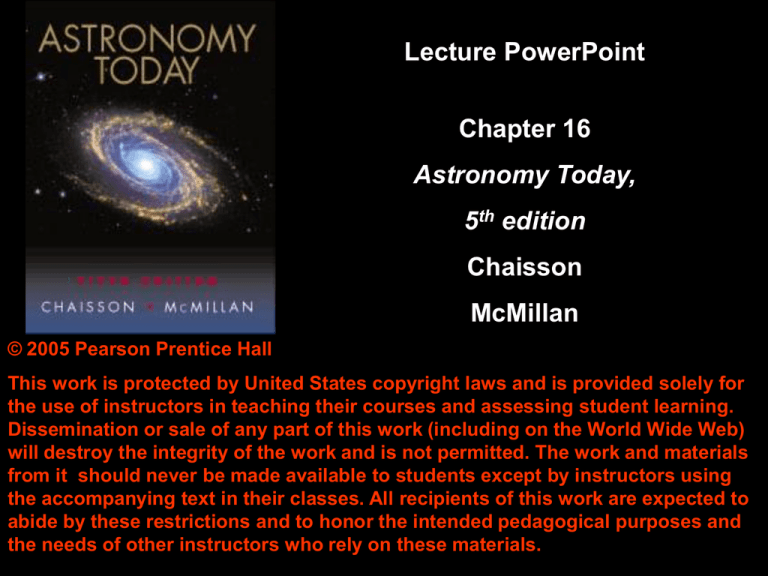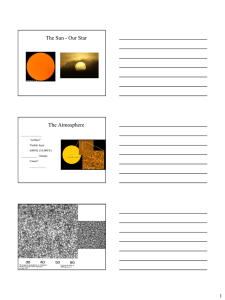
Lecture PowerPoint
Chapter 16
Astronomy Today,
5th edition
Chaisson
McMillan
© 2005 Pearson Prentice Hall
This work is protected by United States copyright laws and is provided solely for
the use of instructors in teaching their courses and assessing student learning.
Dissemination or sale of any part of this work (including on the World Wide Web)
will destroy the integrity of the work and is not permitted. The work and materials
from it should never be made available to students except by instructors using
the accompanying text in their classes. All recipients of this work are expected to
abide by these restrictions and to honor the intended pedagogical purposes and
the needs of other instructors who rely on these materials.
Chapter 16
The Sun
Composite pic of
3 extreme UV
wavelength
images taken by
the EIT
instrument on
board the SOHO
spacecraft
Units of Chapter 16
Physical Properties of the Sun
The Heart of the Sun
Nuclear Fusion energy, E =mc2
The p-p process, 4H He
The Solar Interior
Energy Transfer Mechanisms:
Conduction, Convection, Radiation
Core
Radiation zone
Convection zone
The Solar Atmosphere
Photosphere
Chromosphere
Corona
Prominent features of each
The Active Sun
Sunspots
Sunspot cycles
Babcock Dynamo model
Solar-Terrestrial Interactions
Spaceweather
Aurorae
Ice Ages, Global Warmings
Observations of Solar Neutrinos
Neutrino Observatories
The Fundamental Forces
Solar Observatories
Ground based
Space based
How Big Is The Sun?
Earth
Limb Darkening
Light passing
through more of
atmosphere at the
edges of a gas
body means more
scattering and
absorption on the
way to us
To Earth
Some Physical Properties of the Sun
Radius: 700,000 km (420,000mi)
Mass: 2.0 × 1030 kg (2.2 x 1027 tons)
Density: 1400 kg/m3 = 1.4 gm/cm3
(ρwater = 1.0 gm/cm3)
Rotation:
Differential (different latitudes rotate at
different speeds)
Rotation period is about a month (29d)
Surface Temperature: 5800 K
Apparent surface of Sun is photosphere
Place where opacity = 1
(like a fog bank or cloud bottom)
Structure of the Sun
Outer layers are
not to scale.
The core is where
nuclear fusion
takes place.
Solar Structure & Features
Solar Abundances of Elements
Physical Properties of the Sun
Luminosity( )– total energy radiated by the Sun
can be calculated from the fraction of that
energy that reaches Earth. [ L = 4πσR2T4]
Solar constant – amount of Sun's energy
reaching Earth is 1400 W/m2 = 1.4 kW/m2.
This is per second!
In one hour a square meter of area gets
about 5000 kW of energy!
Total luminosity is about 4 × 1026 W = 400 YW
the equivalent of 10 billion 1-megaton
nuclear bombs per second.
16.1 Physical Properties of the Sun
This diagram
illustrates how one
can extrapolate
from the radiation
hitting Earth to the
entire output of the
Sun [Luminosity]
Surface area of a sphere
A = 4πR2
So, Luminosity
L = (4πR2)(σT4) =
Energy
emitted by
Sun/unit area
E = σT4
16.2 The Heart of the Sun
Given the Sun’s mass and energy production,
we find that, on the average, every kg of the
sun produces about 0.2 milliwatts of energy.
This is not much – gerbils could do better –
but it continues through the 10-billion-year
lifetime of the Sun.
We find that the total lifetime energy output is
about 3 × 1013 J/kg.
This is a lot, and it is produced steadily, not
explosively. How?
16.2 The Heart of the Sun
Nuclear fusion is the energy source for the Sun.
In general, nuclear fusion works like this:
nucleus 1 + nucleus 2 → nucleus 3 + energy
But where does the energy come from?
• It comes from the mass: if you add up the masses of the
initial nuclei, you will find that it is more than the mass of
the final nucleus.
• The relationship between mass and energy comes from
Einstein’s famous equation:
E = mc2
In this equation, c is the speed of light, which is a very
large number.
16.2 The Heart of the Sun
What this equation is telling us is that a
small amount of mass is the equivalent of a
large amount of energy – tapping into that
energy is how the Sun keeps shining so
long.
Nuclear power plants in use presently rely
on nuclear fission energy. This also yields a
lot of energy but 100 to 1000 times less per
kg than the fusion of hydrogen in stars.
Current energy research is trying to make
economical fusion reactors (ITER Project).
16.2 The Heart of the Sun
Nuclear fusion requires that like-charged nuclei
get close enough to each other to fuse.
This can happen only if the temperature is
extremely high – over 10 million K.
16.2 The Heart of the Sun
The previous image depicts proton–proton fusion.
In this reaction:
proton + proton → deuteron + positron + neutrino
The positron is just like the electron except
positively charged (it is anti-matter); the neutrino
is also related to the electron but has no charge
and an extremely tiny mass.
In more conventional notation:
16.2 The Heart of the Sun
This is the first step in a three-step fusion process that
powers most stars.
16.2 The Heart of the Sun
The second step is the formation of an
isotope of helium:
The final step takes two of the helium-3
isotopes and forms helium-4 plus two
protons:
pp – cycle details
proton
proton
positron
electron
deuterium
positron
fusion
annihilation
neutrino
gamma rays
deuterium
Helium-3
fusion
fusion
by E = mc2
16.2 The Heart of the Sun
The ultimate result of the process:
The helium stays in the core;
The energy is in the form of gamma rays,
which gradually lose their energy as they
travel out from the core, emerging as visible
light;
The neutrinos escape without interacting.
16.2 The Heart of the Sun
The energy created in the whole reaction can be
calculated by the difference in mass between the
initial particles and the final ones – for each
interaction it turns out to be 4.3 × 10–12 J.
This translates to 6.4 × 1014 J per kg of hydrogen,
so the Sun must convert 4.3 million tons of matter
into energy every second.
The Sun has enough hydrogen left to continue
fusion for about another 5 billion years.
Then it will swell into a red giant and engulf the
inner planets. After that it will shrink into a white
dwarf smaller than the Earth.
16.3 The Solar Interior
Mathematical models, consistent with
observation and physical principles, provide
information about the Sun’s interior.
In equilibrium, inward
gravitational force
must be balanced by
outward pressure:
This is called
Hydrostatic Equilibrium
16.3 The Solar Interior
Doppler shifts of solar spectral lines indicate a complex
pattern of vibrations. This method of studying of the
Sun’s interior this way is called Helioseismology.
16.3 The Solar Interior
Solar density and
temperature, according
to the standard solar
model:
16.3 The Solar Interior
Energy transport
The radiation zone is relatively transparent; the
cooler convection zone is opaque:
There is energy transport by conduction in the Sun
Need high densities for that (like in your iron)
16.3 The Solar Interior
The visible top layer of
the convection zone is
granulated, with areas
of upwelling material
surrounded by areas of
sinking material:
16.4 The Solar Atmosphere
Spectral analysis can tell us what elements are
present, but only in the chromosphere and
photosphere:
16.4 The Solar Atmosphere
The cooler chromosphere is above the
photosphere
Difficult to see
directly, as
photosphere is too
bright, unless Moon
covers photosphere
and not chromosphere
during eclipse:
16.4 The Solar Atmosphere
Small solar storms in chromosphere emit spicules:
16.4 The Solar Atmosphere
Solar corona can be seen during eclipse if both
photosphere and chromosphere are blocked:
16.4 The Solar Atmosphere
Corona is much hotter than layers below it –
must have a heat source, probably
electromagnetic interactions.
16.5 The Active Sun
Sunspots appear dark
because slightly cooler
(~3800K so less bright) than
their surroundings (5800K):
Sunspots are the size
of Earth or larger!
(DE = 12,750 km)
Umbra
Penumbra
16.5 The Active Sun
Sunspots come and go,
typically in a few days.
Sunspots are linked by pairs
of magnetic field lines:
16.5 The Active Sun
The Sun has an 11-year sunspot cycle, during
which sunspot numbers rise, fall, and then rise
again:
This is called the min-max
sunspot cycle
16.5 The Active Sun
This is really a 22-year cycle magnetic cycle,
because the spots switch magnetic polarities
between the northern and southern hemispheres
every 11 years.
Maunder minimum: few, if any, sunspots seen:
Little Ice Age
This is a time corresponding to the Maunder
Minimum in sunspot activity. Climatologists have
recorded the expansion of arctic pack ice, the
wide scale advance of glaciers, severe winters and
other severe cooling events on Earth.
People were ice skating in Holland in July and crop
failures led to widespread famines.
This is an example of solar-terrestrial interaction.
16.5 The Active Sun
Areas around sunspots are active; large
eruptions may occur in photosphere.
Solar prominence is large sheet of ejected gas:
16.5 The Active Sun
A Solar flare is a large explosion on Sun’s surface, emitting
a similar amount of energy to a prominence, but in seconds
or minutes rather than days or weeks:
They are dangerous to
our satellites and energy
grids and have caused
communication failures
and massive power
outages in the past.
16.5 The Active Sun
Solar wind escapes Sun mostly through coronal
holes, which can be seen in X-ray images:
16.5 The Active Sun
Solar corona changes along with sunspot
cycle; is much larger and more irregular at
sunspot peak:
16.6 Observations of Solar Neutrinos
Neutrinos are emitted directly from the core of
the Sun, and escape, interacting with virtually
nothing. Being able to observe these neutrinos
would give us a direct picture of what is
happening in the core.
Unfortunately, they are no more likely to interact
with Earth-based detectors than they are with the
Sun; the only way to spot them is to have a huge
detector volume and to be able to observe single
interaction events.
16.6 Observations of Solar Neutrinos
SuperKamiokande
One large solar
neutrino detector;
interactions take place
in the water, which
reaches the top of the
dome when full, and
detected by the glass
photomultiplier tubes:
16.6 Observations of Solar Neutrinos
Some directional information is available, but it
is very coarse; the black dot in the center
indicates the actual size of the Sun:
16.6 Observations of Solar Neutrinos
Detection of solar neutrinos has been going on
for more than 30 years now; despite very
different detection methods and energy
sensitivities, for a long time all experiments
agreed that they were seeing about 30–50% of
the expected number of neutrinos.
This was called the Solar Neutrino Problem
Solution could be:
• Problem with the solar model
• Problem with our understanding of neutrinos
The second option seems more likely now.
Homestake Gold Mine Neutrino Data
Davis/Bahcall-Chlorine Expt.
Neutrino Theory vs. Expt. (2000)
Neutrino Oscillations
There are three types of neutrinos:
Electron, muon and taon neutrinos
Some theories predict that they can transform
into each other
The Sudbury Neutrino Observatory (SNO)
was able to support this idea
Summary of Chapter 16
• Main interior regions of Sun: core, radiation
zone, convection zone, photosphere,
chromosphere, transition region, corona, solar
wind
• Energy comes from nuclear fusion; produces
neutrinos along with energy
• Standard solar model is based on hydrostatic
equilibrium of Sun
• Study of solar oscillations leads to information
about interior
Summary of Chapter 16, cont.
• Absorption lines in spectrum tell composition
and temperature
• Sunspots associated with intense magnetism
• Number of sunspots varies in an 11-year
cycle
• Large solar ejection events: prominences,
flares, and coronal ejections
• Observations of solar neutrinos show deficit;
yet to be definitively explained



